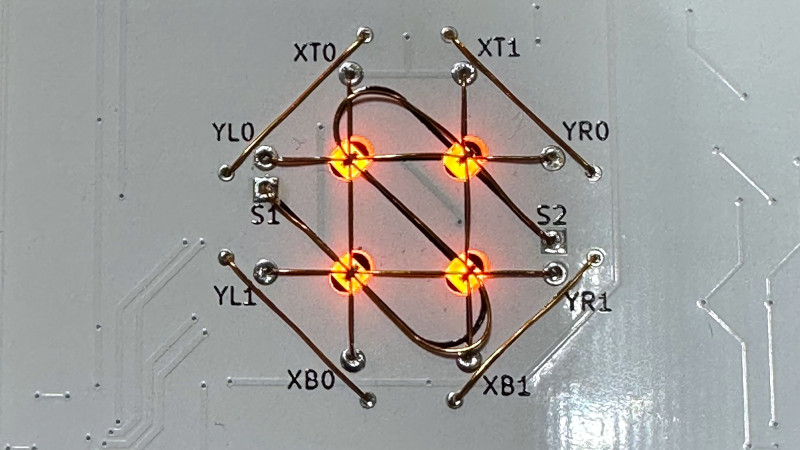Core memory, magnetized memory using tiny magnetic rings suspended on a grid of wires, is now more than five decades obsolete, yet it exerts a fascination for hardware hackers still. Not least [Andy Geppert], who’s made a nibble, four bits of it, complete with interactive LED illumination to show state. Best of all, it’s on a badge Simple Add-On (SAO) for fun and games at your next hacker con.
Aside from it being a fun project, perhaps the most interesting part comes in the GitHub repository, where can be found the schematic for the device. He’s built all the drive and sense circuitry himself rather than finding an old-stock core memory driver chip, which gives those of us who’ve never worked with this stuff the chance to understand how it works. Beyond that it takes input from the Stemma or SAO ports to a GPIO expander, which provides all the lines necessary to drive it all.
To show it in action he’s posted a video which we’ve placed below. If you’re hungry for more, it’s not [Andy]’s first outing into core memory.
















I think there is a minor misnomer in the title. It is four 1 bit memories which can also be read serially as 4 bits. Computer core memories are made with planes of cores with as many planes as bits in a word. Plus a couple parity/error correction planes on most. One would probably not call this 4 bit example a nibble.
Of course in some applications they have a single plane that is used more like the rope memories in the Apollo computers – an EEPROM so to speak,
And then another thing…. wasn’t 4 bits a “nybble’ as opposed to “nibble?”
@Observer said: ‘And then another thing…. wasn’t 4 bits a “nybble’ as opposed to “nibble?”’
In computing, a nibble (occasionally nybble, nyble, or nybl to match the spelling of byte) is a four-bit aggregation, or half an octet.[1]
[One] https://en.wikipedia.org/wiki/Nibble
Iirc, a nibble was part of a word which was composed of bytes. Handy in bookkeeping, don’t recall much use outside of that.
Also worth mentioning is the diode matrix.
It’s a forerunner to EPROM and ROM technology.
Radio amateurs did use diode matrixes to program CW IDs for morse code beacons.
Early FM repeaters did use them too, after leaving spinning discs with morse code behind.
Simple morse beacons were also used for fox hunt (directional finding, now aka foxoring).
Sometimes the morse pattern was just a beep, sometimes it contained a letter and a number.
For the latter, diode matrixes were easy to build.
In Australia, a nibble of a SAO has a completely different meaning.
That’s really fanny. What meaning is it – for us, non-native speakers, please?
https://en.wikipedia.org/wiki/SAO_(biscuit)
Possibly explains why they’re marketed as Tuckers here
Um actually, the SAO is called a Shitty Add-on per the spec published on hackaday
https://hackaday.com/2019/03/20/introducing-the-shitty-add-on-v1-69bis-standard/
And it was renamed here for blatantly obvious reasons.
It’s not “blatantly obvious” to Europeans. I reject the notion that one could be offended by it. We are not in a business meeting here with the CEO, but among like minded hardware hackers.
I’d rather not teach my kid to solder on something she couldn’t tell her first grade teacher about.
I salute those with too much free time… I mean it.
I’ve loved some videos on how people took old core memory to use it, including from NASA and they had the foresight to READ the data which yes was still there all these decades from then… Have a million other things to do than play with core memory (anyone making a delay-line kit?) but cool and good STEM project.
Thinking as I’m typing perhaps quantum supercomputing is the new “Core” memory with each core being an atom and the equipment around it to read it and use it. Normally a single atom means nothing to us but like a wire or a magnetic spin in a ferric ring it can mean a lot and if used perfectly the limited tiny bits can be used for fantastic things. There’s some neat YouTube vids I haven’t seen yet on how rope memory (wires through magnetic cores) was used in Pinball machines for critical memory/math since no transistors yet or they cost $25 each not adjusted for inflation so making a legit “Computer” would have been way out of the question.
Where do we get the magnetic stylus? Where is the BOM?
How does the magnetic stylus get sensed?
The magnet on the stylus is strong enough to flip the bits of the core… so all you need to do is set it to 0 and the stylus will flip it back to a one… if you read it, you’ll see a 1 wherever the stylus has been (or is.)